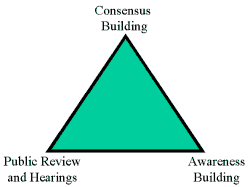Decision-Making
| The Seven Triads of Sustainability: | |||||||
| 2 | |||||||

Therefore taking effective decisions that have a positive impact on the environment as a whole - local and global, is imperative. Creating collective agreement and opinion reached by the community is important (consensus building) for action; initiating action on decisions taken necessitates the overall understanding of the causes and effects (awareness building), and the active involvement of all members of the community to discuss and debate the issues concerned (review and hearings)
Decision-making also includes such issues as ownership, visioning, flexibility, empowerment, informed consent, community choice etc.
Environmental activities in Minamata City, Japan, have been featured by the experience of Minamata Disease, as well as people's efforts to overcome the issues. Minamata Disease, being first discovered in 1956, was caused by the consumption of fish or shellfish contaminated by methyl mercury compound discharged from a chemical plant, and it brought about disorder of the central nervous system. According to the statistics of the government, 12,617 people have been certified as Minamata Disease patients (of which 1,408 people died). Even after the issue of compensation for patients was solved, there was an urgent need for people to overcome social issues faced in the community where cooperative spirit among was severely destroyed by the tragic incident.
One of the core methods that was adopted for rebuilding the community was 'Jimotogaku' (Community Studies), which is the concept developed by Mr. Tetsuro Yoshimoto, who is the head of an NGO called Jimotogaku Association, as well as an officer of the Environment Section of Minamata City Government. The concept of 'Jimotogaku' essentially puts the community in the driver's seat - the spot for the decision making, to formulate, develop and guide local development in the neighborhood and the city. The core idea that lies under 'Jimotogaku' is how to shift from the excess industrialized / modernized society to the creation of the society where people can coexist with nature, and establish sustainable lifestyles. In order to achieve this at the local level, the capacity of the residents to make appropriate judgment and the ability to take actions need to be fostered. This requires the sufficient understanding by the residents about the local environment, anticipate/expect the results and outcomes/sub-effects that the external pressures will bring about, and prevent problems by creating its own unique life culture. Only after understanding fully the production, consumption, and reproduction cycle existing in the natural environment in their community could residents develop their own action plans to achieve sustainability.
The 'Jimotogaku' is implemented through activities including mapping of natural resources and water flows in a community, researching the culture, history, tradition, and customs of a community, analysis of the lifestyles of the people, production and consumption processes of various products consumed, the treatment and recycling process of wastes generated in a community, environmental education linked closely to the living culture of a community, and organization of citizen's discussion forums where community residents can discuss and share views on their concerns, needs and wishes, as well as exchange views with other sectors, such as the local government.
The results of Jimotogaku activities were reflected in the establishment of Basic Environmental Plan, ISO14001 activities, development of the local information database, and other development and environmental planning by the city office. The enhanced knowledge of people on their community also resulted in strengthening of their voice in a dialogue and the discussion forums with the city office and businesses. The sufficient knowledge not only on the environment but also on living culture (tradition, culture, history, lifestyles, etc.) of the community enhanced people's decision making capacities in designing their unique living environment.
The history of conceiving and executing public budgets in Brazil is marked by serious deformations related to power concentration, resource waste, political affairs and corruption. In Porto Alegre, this history has been changed. Seven years ago, the City Hall of Porto Alegre created an innovative and revolutionary system to formulate and follow-up the municipal budget.
In this system, named as Participative Budget, there are not only technicians and government leaders who, closed in their offices, decide on the collection of taxes and public money spending. It is the population, through a debate and consult process, who defines and decides on amounts of income and expense, as well as where and when the investments will be done, which are the priorities and which are the plans and actions to be developed by the Government. The Participative Budget has proved that the democratic and transparent administration of the resources is the only way to avoid corruption and mishandling of public funds. Despite certain technocratic opinions, the popular participation has provided efficient spending, effective where it has to be and with results in public works and actions of great importance for the population. Since its beginning, the projects decided by the Participative Budget represent investments over 700 million dollars, mainly in urban infra-structure and upgrading the quality level of the population.
| The Seven Triads of Sustainability: | |||||||
| 2 | |||||||
 |
Return to the cover page Contact: Hari Srinivas - hsrinivas@gdrc.org |